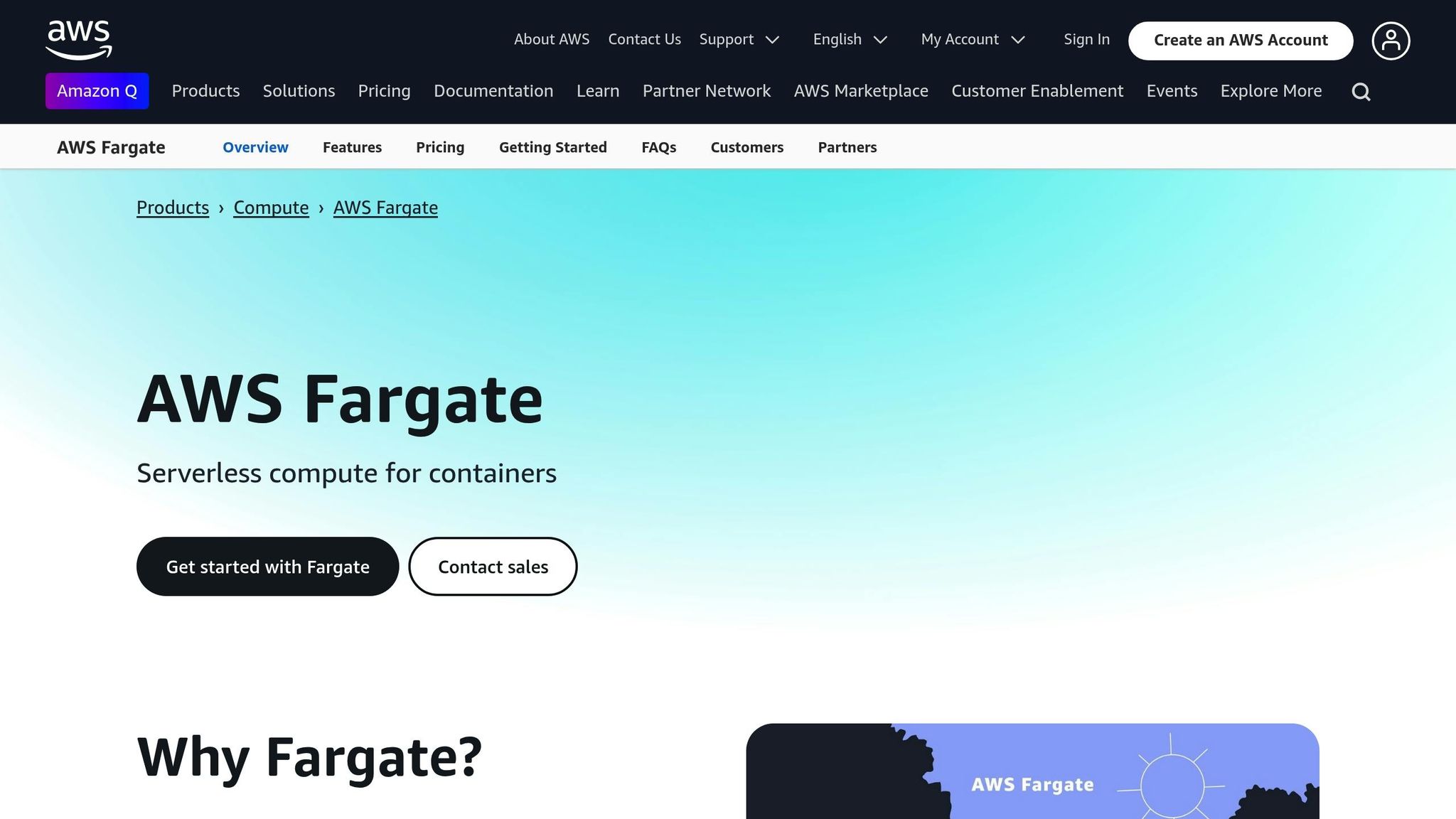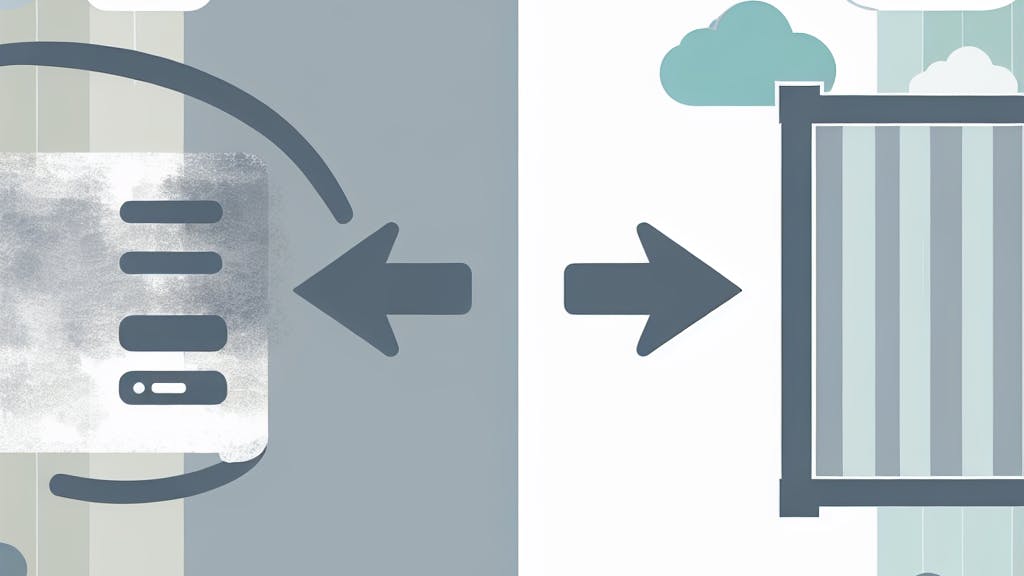Choosing between AWS Fargate and EC2 for your containerized applications boils down to control vs. simplicity.
- Fargate: Fully managed, serverless. Ideal for quick deployments, automatic scaling, and minimal infrastructure management. Best for microservices, batch jobs, and dev/test environments.
- EC2: User-managed infrastructure. Offers full control, customizable hardware, and cost-saving options like Reserved Instances. Best for GPU workloads, large-scale apps, and custom configurations.
Key Differences at a Glance:
| Feature | Fargate | EC2 |
|---|---|---|
| Management | Fully managed by AWS | User-managed |
| Billing | Per second, task-based | Per instance hour |
| Scaling | Automatic at task level | Manual, instance-level |
| Control | Task-level only | Full instance control |
| Best For | Microservices, sporadic tasks | GPUs, custom infrastructure |
Quick Tip: Use Fargate for simplicity and EC2 for control. Your choice depends on workload needs, cost considerations, and technical priorities.
AWS Fargate Overview

AWS Fargate makes deploying containers easier by eliminating the need to manage infrastructure. This serverless compute engine works with Amazon ECS and EKS, allowing you to run containers without worrying about servers. Below, we’ll break down Fargate's main functions, advantages, and limitations.
Fargate Core Functions
Fargate automates critical container infrastructure tasks, including:
- Resource Provisioning: Automatically allocates CPU and memory based on your container’s requirements.
- Cluster Management: Handles container placement and scaling without manual intervention.
- Infrastructure Updates: Takes care of security patches and system maintenance.
- Load Distribution: Efficiently spreads workloads across available resources.
Fargate Benefits
Here’s a quick look at what Fargate offers:
| Benefit | Description | Impact |
|---|---|---|
| No Infrastructure Management | No need to manage or provision servers | Reduces operational effort |
| Automatic Scaling | Adjusts resources to match application demands | Improves resource efficiency |
| Pay-As-You-Go Pricing | Charges only for what you use | Helps control costs |
| Enhanced Security | Isolates each task in its own runtime environment | Adds an extra layer of protection |
Fargate Constraints
1. Resource and Platform Limitations
Fargate supports only fixed CPU and memory configurations and is limited to Linux containers. It doesn’t support GPUs or provide direct host-level access.
2. Cost Challenges
While convenient, Fargate can be more expensive than EC2 at high usage levels. Additionally, there are no reserved instance or savings plan options to lower costs.
3. Network Performance Issues
Network performance can be less consistent compared to EC2 since you don’t control the underlying network setup.
These limitations mean Fargate is best suited for standard containerized applications that don’t require custom infrastructure or direct access to the host environment.
EC2 Container Deployment
Amazon EC2 allows you to deploy containers while giving you full control over compute resources and the underlying infrastructure.
EC2 Main Features
Here’s what EC2 offers for container deployment:
| Feature | Description | Benefit |
|---|---|---|
| Instance Control | Full access to EC2 instance configuration | Lets you optimize for specific needs |
| Resource Flexibility | Support for various instance types and sizes | Matches the exact requirements of workloads |
| OS Selection | Choose and customize your operating system | Tailors to application needs |
| Network Control | Manage network interfaces directly | Enables advanced networking setups |
EC2 Benefits
EC2 provides several advantages for deploying containers:
- Cost Options: EC2 offers flexible pricing models like Reserved Instances and Spot Instances. Reserved Instances can help you save significantly compared to On-Demand pricing.
- Full Infrastructure Control: You have complete authority over instance types, operating systems, network configurations, security groups, storage, and even CPU and memory allocations. This level of control ensures you can fine-tune performance as needed.
EC2 Challenges
While EC2 offers flexibility, it also comes with some challenges:
- Management Overhead: You’ll need to handle tasks like OS updates, security patches, capacity planning, and scaling operations yourself.
- Complex Setup: Setting up the container runtime, orchestration tools, monitoring systems, and load balancers can be time-consuming.
- Resource Sizing: Properly sizing EC2 instances is critical to avoid wasting resources or running into performance issues.
Choosing EC2 means balancing its high level of control and flexibility with the added responsibility of managing infrastructure. For organizations with specific infrastructure needs or existing expertise in EC2, this trade-off often makes sense. These considerations become even more apparent when comparing EC2 with Fargate.
sbb-itb-6210c22
Comparing Fargate and EC2
This section breaks down differences in launch speed, scaling, cost, management, and security.
Speed and Scale Comparison
| Metric | Fargate | EC2 |
|---|---|---|
| Container Launch Time | 30-45 seconds | 2-3 minutes startup time |
| Auto Scaling Response | Immediate container-level scaling | Instance-level scaling with potential delay |
| Resource Granularity | Per-task resource allocation | Instance-level resource allocation |
| Cold Start Impact | Minimal impact | May require instance warm-up |
Price Comparison
Pricing models directly influence overall expenses.
| Cost Factor | Fargate | EC2 |
|---|---|---|
| Billing Unit | Per second for vCPU and memory | Per instance hour |
| Minimum Billing | 1-minute minimum | 60-minute minimum |
| Resource Utilization | Pay for exact container resources | Pay for entire instance capacity |
| Additional Costs | No extra management fees | Instance management overhead |
Management Requirements
| Aspect | Fargate | EC2 |
|---|---|---|
| Infrastructure Management | Fully managed by AWS | Customer managed |
| Patching Responsibility | AWS handled | Customer responsibility |
| Capacity Planning | Automated | Manual planning required |
| Monitoring Setup | Built-in container insights | Requires manual configuration |
Security Features
| Security Feature | Fargate | EC2 |
|---|---|---|
| Task Isolation | Automatic task-level isolation | Manual security group configuration |
| Patch Management | Automated security updates | Manual security updates |
| Compliance | Built-in compliance features | Custom compliance implementation |
| Network Security | Task-level networking | Instance-level networking |
These comparisons highlight key factors to consider when choosing the best launch type for your specific workload needs.
Selecting a Launch Type
Best Uses for Fargate
Fargate is ideal for workloads where managing infrastructure isn't a priority. Here's how it stacks up:
| Workload Type | Advantages | Examples |
|---|---|---|
| Microservices | Scales automatically, isolates resources | API services, web apps |
| Batch Processing | Billed per task, starts quickly | Data processing, ETL jobs |
| Dev/Test Environments | No infrastructure management required | CI/CD pipelines |
| Sporadic Workloads | Pay only for what you use | Scheduled tasks, periodic jobs |
Best Uses for EC2
EC2 shines in scenarios that demand more control and customization. Take a look:
| Use Case | Advantage | Example Applications |
|---|---|---|
| GPU Workloads | Direct access to hardware | Machine learning model training |
| Large-Scale Applications | Cost-efficient for steady usage | High-traffic web services |
| Custom Infrastructure | Full control over instances | Integrating with legacy systems |
| Specialized Configurations | OS-level customization | Meeting strict security requirements |
These examples highlight when each option might be the better fit.
Decision Criteria
When choosing between Fargate and EC2, consider these factors:
-
Operational Needs
Align your choice with your technical and operational requirements. Fargate is great for automated isolation, while EC2 offers full control for custom setups. -
Cost Considerations
- Consistent Workloads: EC2 is often more cost-effective for steady-state applications.
- Variable Workloads: Fargate's per-second billing is better for workloads with fluctuating demand.
-
Technical Priorities
- Container Isolation: Fargate provides task-level isolation for added security.
- Infrastructure Control: EC2 allows for greater flexibility and customization.
- Resource Management: EC2 offers fine-tuned control over instance resources.
For most modern containerized applications that prioritize ease of use, Fargate is a straightforward choice. However, if your focus is on specific infrastructure needs or optimizing costs at scale, EC2 may be the better option.
Summary
Main Points
Fargate and EC2 differ in how they handle management, costs, resource control, and scaling. Here's a quick breakdown of the key differences:
| Aspect | Fargate | EC2 |
|---|---|---|
| Infrastructure | Managed by AWS | Managed by the user |
| Cost | Per-second, task-based | Instance-based |
| Control | Task-level | Full instance control |
| Use Cases | Microservices, batch jobs | GPU, large-scale apps |
| Scaling | Automatic at task level | Instance-level scaling |
These distinctions tie back to the detailed analysis covered earlier.
Key considerations to keep in mind:
- Operational Needs: Fargate is ideal for quick deployments with minimal management, while EC2 is better suited for applications requiring custom hardware or operating system configurations.
- Resource Usage: EC2 is cost-effective for steady, predictable workloads. Fargate shines when dealing with workloads that fluctuate.
-
Technical Factors:
- Fargate excels in task-level security isolation.
- EC2 provides direct access to instance resources.
- EC2 supports GPUs and custom networking setups.
Ultimately, your choice should align with your workload demands and your ability to manage infrastructure. Fargate offers simplicity for standard containerized applications, while EC2 is better for those needing detailed control over their environment.


